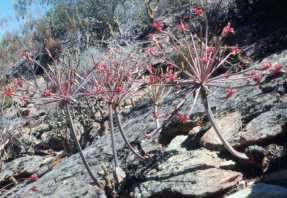Brunsvigia josephinae
Brunsvigia josephinae (Redouté) Ker Gawl.
Family: Amaryllidaceae
Common names: candelabra lily (Eng.); kandelaarblom, lantanter (Afr.)
Introduction
This plant has by far the biggest bulb and inflorescence among the geophytes in South Africa. Its large striking umbels are easily visible in the veld when in bloom.

Description
Description
The plants are deciduous and grow in winter. The leaves only appear in winter and rapidly die back in summer before the flowers are borne in late summer to autumn. The plants including the inflorescence grow to about 0.65 m in height. The bulbs are usually exposed, 200 mm in diameter and covered with dry, papery tunics. The 8-20 leaves are blueish-grey, strap-like, and about 600 x 200 mm.
The 30-40 flowers are carried on open, widely spreading umbels, are dark red, and orange-yellow toward the base. The individual flowers are tubular, measuring 15mm long and produce nectar, which is enjoyed by sugarbirds. The fruiting body is a capsule 30-50 mm long, more or less cylindrical. The seeds are ovoid, reddish-green, fleshy, 5-10 mm in diameter and are dispersed when the capsule ruptures as they are blown by the wind. From seed, plants may take up to 14 years to mature.
Distribution and habitat
Distribution description
Plants occur in the winter-rainfall area from the western Karoo, Worcester, Malgas to Willowmore. They are found usually on cooler and exposed southern slopes in sandy to clay soils in broken renosterveld , mostly in Malmesbury shale, limestone and weathered sandstone. Being deciduous geophytes, they are able to withstand seasonal droughts and very low temperatures in the winter and are also resistant to veld fires.

Derivation of name and historical aspects
History
The family name Amaryllidaceae is from the name Amaryllus, a pretty shepherdess mentioned by Theocritus, Virgil and Ovid. Edmund Spenser used the name in 1595 for Alice, daughter of Sir John Spenser, later Countess of Derby and ancestress of the Princess of Wales. The genus name Brunsvigia was in honour of the house of Brunswick. The specific name josephinae was named in honour of the Empress Josephine, Napoleon's first wife. There are approximately 20 species of Brunsvigia found throughout southern Africa. Brunsvigia orientalis is another well-known species.
Ecology
Ecology
The tubular flowers are borne on a wide umbel seated on long stalks up to about 650 mm long. The flowers are thus perfectly advertised to nectar-eating sugarbirds who pollinate the flowers. Seeds are dispersed by the tumbling of the inflorescence in the wind.
Uses
Use
Besides its value in ornamental horticulture, the dry bulb tunics are used as a wound dressing. It is known that young Xhosa men use the tunics as plasters after circumcision.
Growing Brunsvigia josephinae
Grow
Propagation is by seed or vegetatively. Seeds should be sown soon after ripening as the seed starts germinating then. A coarse medium such as river sand is ideal, and seedlings must be kept moist, but not overwatered. It will take many years for these to reach flowering age.
It is also possible to separate bulbs from mature plants that multiply under the ground.
Another vegetative method is to cut away a small section of the bulb base where the roots emerge and plant it into a coarse medium. Bulblets should appear at the base within a few months. This must be done in the vegetative stage of the growth cycle i.e. just before the leaves appear.
These plants can be grown in the garden in suitable climates, or in pots. They are complemented with other geophytes from the amaryllid family such as Boophane, Amaryllis and Nerine which all put up a spectacular show in summer. They all require good drainage and a dry, dormant period to thrive.
Not many pests are known to attack B. josephinae, except the amaryllis borer, a caterpillar with yellow and black markings on its body. The caterpillar is most active at night where it can be found boring into the leaves as well as fruits. It is advisable to use biological control by introducing insect-eating birds to the garden since sunbirds are nectar feeders, not insectivorous! Alternatively a systemic insecticide may be used.
References
- Dyer, R.A. 1975. The genera of southern African plants, vol. 1. Botanical Research Institute, Pretoria.
- Jackson, W.P.U. 1990. Origins and meanings of South African plant genera. University of Cape Town.
- Manning, J., Goldblatt, P. & Snijman, D. 2002, The colour encyclopedia of Cape bulbs. Timber Press, Oregon, USA. Author Werner Voigt Karoo Desert National Botanical Garden August 2004
Credits
Werner Voigt
Karoo Desert National Botanical Garden
August 2004
Plant Attributes:
Plant Type: Bulb
SA Distribution: Eastern Cape, Northern Cape, Western Cape
Soil type: Clay, Loam
Flowering season: Late Summer, Autumn
PH: Alkaline
Flower colour: Red, Yellow, Orange
Aspect: Full Sun
Gardening skill: Easy
Special Features:
Horticultural zones











Rate this article
Article well written and informative
Rate this plant
Is this an interesting plant?
Login to add your Comment
Back to topNot registered yet? Click here to register.